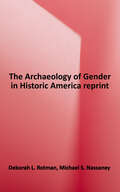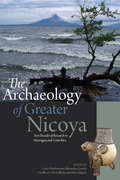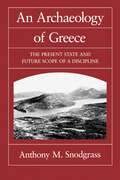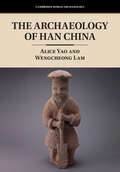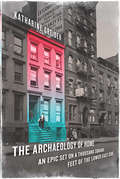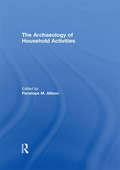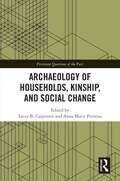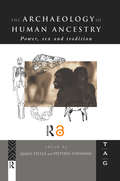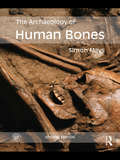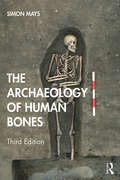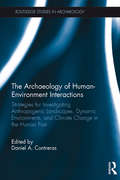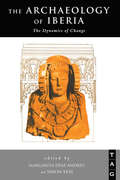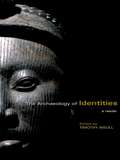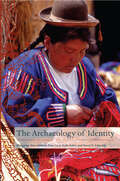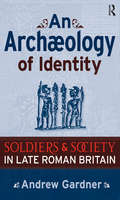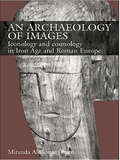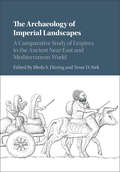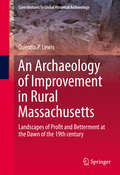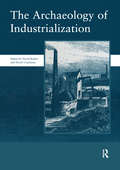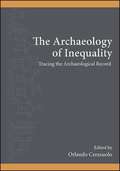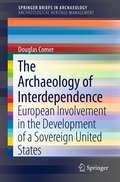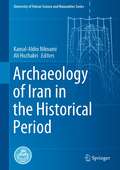- Table View
- List View
The Archaeology of Gender in Historic America (American Experience in Archaeological Perspective)
by Deborah L. RotmanPatriarchy, colonialism, and the capitalist mode of production have shaped gender through time and across many different cultures. In historic America, gendered social relations were created, codified, and reproduced through the objects used in cultural rituals, the spatial organization of houses, the construction of village landscapes, and the institutions of society, in addition to other social, ideological, economic, and political forces. From domestic spaces to the public realm, Deborah Rotman contextualizes gender and the associated social relationships from the colonial period through the twentieth century. By exploring how individuals and families negotiated and mediated these relationships, she sheds light on how prescriptive gender categories affected those expected to follow them and examines how diverse groups responded to popular gender ideologies. Additionally, she reveals the ways gender and society influence each other, exposing how American normative notions of masculinity and femininity intersect with class, ethnicity, race, sexuality, and identity. Albeit, Rotman contends, they do not intersect in mutually supportive ways, ultimately giving rise to transformative social changes.
The Archaeology of Greater Nicoya: Two Decades of Research in Nicaragua and Costa Rica
by Larry Steinbrenner Alexander Geurds Geoffrey G. McCafferty Silvia SalgadoThe Archaeology of Greater Nicoya is the first edited volume in a quarter century to provide an overview of this fascinating archaeological subarea of Mesoamerica, encompassing Pacific Nicaragua and northwestern Costa Rica. Inhabited by diverse peoples of Mesoamerican origin centuries before Spanish colonization, Greater Nicoya remains controversial in the twenty-first century as scholars struggle to achieve consensus on questions of geography, chronology, and cultural identity. Drawing on approaches ranging from ethnohistory to bioarchaeology to scientific and culture-historical archaeology, the book is organized into sections on redefining Greater Nicoya, projects and surveys, material culture, and mortuary practices. Individual chapters explore Indigenous groups and their origins, extensive summaries of the three largest scholarly archaeological projects completed in Pacific Nicaragua in the last quarter century, clear evidence of Mesoamerican connections from Costa Rica’s Bay of Culebra, detailed histories of lithic analysis and rock art studies in Nicaragua, new insights into mortuary and cultural practices based on osteological evidence, and reinterpretations of diagnostic ceramic types as products of related potting communities and the first definitive identification of production centers for these types. Drawing upon new 14C dates, this volume also provides the most substantial revision of the late pre-colonial chronology since the 1960s, a correction that has critical implications for understanding the prehistory of Greater Nicoya.
An Archaeology of Greece: The Present State and Future Scope of a Discipline (Sather Classical Lectures #53)
by Anthony M. SnodgrassClassical archaeology probably enjoys a wider appeal than any other branch of classical or archaeological studies. As an intellectual and academic discipline, however, its esteem has not matched its popularity. Here, Anthony Snodgrass argues that classical archaeology has a rare potential in the whole field of the study of the past to make innovative discoveries and apply modern approaches by widening the aims of the discipline.
The Archaeology of Greek and Roman Troy
by Charles Brian RoseThe Archaeology of Greek and Roman Troy provides a synthetic overview of all excavations that have been conducted at Troy, from the 19th century through the latest discoveries between 1988 and the present. C. Brian Rose traces the social and economic development of the city and related sites in the Troad, as well as the development of its civic and religious centers from the Bronze Age through the early Christian period, with a focus on the settlements of Greek and Roman date. Along the way, he reconsiders the circumstances of the Trojan War and chronicles Troy's gradual development into a Homeric tourist destination and the adoption of Trojan ancestry by most nation-states in medieval Europe.
The Archaeology of Han China (Cambridge World Archaeology)
by Alice Yao Wengcheong LamThe Han Dynasty, which ruled from 202 BCE to 212 CE, is often taken as a reference point and model for Chinese identity and tradition. Covering a geographical expanse comparable to that of the People's Republic of China, it is foundational to understanding Chinese culture and politics, past and present. This volume offers an up-to-date overview of the archaeology of the Han Empire. Alice Yao and Wengcheong Lam study the period via an interdisciplinary approach that combines textual and archaeological evidence. Exploring the dynamics of empire building in East Asia, Yao and Lam draw on recent archaeological discoveries to recast Western Han imperialism as a series of contingent material projects, including the organization of spatial orders, foodways, and the expansion of communication and ritual activities. They also demonstrate how the archaeology of everyday life offers insights into the impact of social change, and how people negotiated their identities and cultural affiliations as individuals and imperial subordinates.
The Archaeology of Home: An Epic Set on a Thousand Square Feet of the Lower East Side
by Katharine GreiderWhen Katharine Greider was told to leave her house or risk it falling down on top of her and her family, it spurred an investigation that began with contractors' diagnoses and lawsuits, then veered into archaeology and urban history, before settling into the saltwater grasses of the marsh that fatefully once sat beneath the site of Number 239 East 7th Street. During the journey, Greider examines how people balance the need for permanence with the urge to migrate, and how the home is the resting place for ancestral ghosts. The land on which Number 239 was built has a history as long as America's own. It provisioned the earliest European settlers who needed fodder for their cattle; it became a spoil of war handed from the king's servant to the revolutionary victor; it was at the heart of nineteenth-century Kleinedeutschland and of the revolutionary Jewish Lower East Side. America's immigrant waves have all passed through 7th Street. In one small house is written the history of a young country and the much longer story of humankind and the places they came to call home.
The Archaeology of Household Activities
by Penelope M. AllisonThis pioneering collection engages with recent research in different areas of the archaeological discipline to bring together case-studies of the household material culture from later prehistoric and classical periods. The book provides a comprehensive and accessible study for students into the material records of past households, aiding wider understanding of our own domestic development.
Archaeology of Households, Kinship, and Social Change (Persistent Questions of the Past)
by Lacey B. CarpenterArchaeology of Households, Kinship, and Social Change offers new perspectives on the processes of social change from the standpoint of household archaeology. This volume develops new theoretical and methodological approaches to the archaeology of households pursuing three critical themes: household diversity in human residential communities with and without archaeologically identifiable houses, interactions within and between households that explicitly considers impacts of kin and non-kin relationships and lastly change as a process that involves the choices made by members of households in the context of larger societal constraints. Encompassing these themes, authors explore the role of social ties and their material manifestations (within the house, dwelling or other constructed space), how the household relates to other social units, how households consolidate power and control over resources, and how these changes manifest at multiple scales. The case studies presented in this volume have broader implications for understanding the drivers of change, the ways households create the contexts for change, and how households serve as spaces for invention, reaction, and/or resistance. Understanding the nature of relationships within households is necessary for a more complete understanding of communities and regions as these ties are vital to explaining how and why societies change. Taking a comparative outlook, with case studies from around the world, this volume will inform students and professionals researching household archaeology and be of interest to other disciplines concerned with the relationship between social networks and societal change.
The Archaeology of Human Ancestry: Power, Sex and Tradition (Theoretical Archaeology Group Ser.)
by James Steele Stephen ShennanHuman social life is constrained and defined by our cognitive and emotional dispositions, which are the legacy of our foraging ancestors. But how difficult is it to reconstruct the social systems and cultural traditions of those ancestors? The Archaeology of Human Ancestry provides a stimulating and provocative answer, in which archaeologists and biological anthropologists set out and demonstrate their reconstructive methods. Contributors use observations of primates and modern hunter-gatherers to illuminate the fossil and artefactual records. Thematic treatment covers the evolution of group size; group composition and the emotional structure of social bonds; sexual dimorphism and the sexual division of labour; and the origins of human cultural traditions. The Archaeology of Human Ancestry is an essential introduction to the subject for advanced undergraduates and researchers in archaeology and biological anthropology. It will also be used by workers in psychology, sociology and feminist studies as a resource for understanding human social origins.
The Archaeology of Human Bones
by Simon MaysThe Archaeology of Human Bones provides an up to date account of the scientific analysis of human skeletal remains from archaeological sites. This completely revised edition reflects the latest developments in scientific techniques for studying human skeletons and the latest applications of those techniques in archaeology. In particular, the sections on ancient DNA and bone stable isotopes have been comprehensively updated, and two completely new chapters have been introduced, covering metric study of the postcranial skeleton and ethical dimensions of the study of human remains. The Archaeology of Human Bones introduces students to the anatomy of bones and teeth, utilising a large number of images. It analyzes the biasing effects of decay and incomplete recovery on burial data from archaeological sites, and discusses what we may learn about burial rites from human remains. Subsequent chapters focus on demographic analysis of earlier populations, normal skeletal variation, disease and injury, isotopic and DNA analysis of bone, the study of cremated bone and ethical aspects of working with ancient human remains. Current scientific methods are explained, alongside a critical discussion of their strengths and weaknesses. The ways in which scientific analyses of human skeletal remains can contribute to tackling major archaeological or historical issues is illustrated by means of examples drawn from studies from around the world. Technical jargon is kept to a minimum, and each chapter contains a summary of the main points that a student should grasp and a list of further reading targeted to enable students to follow up major issues covered in the book. Featuring case studies from around the world and with copious illustrations, The Archaeology of Human Bones continues to be a crucial work for students of archaeology.
The Archaeology of Human Bones
by Simon MaysThe Archaeology of Human Bones provides an up to date account of the analysis of human skeletal remains from archaeological sites, introducing students to the anatomy of bones and teeth and the nature of the burial record. Drawing from studies around the world, this book illustrates how the scientific study of human remains can shed light upon important archaeological and historical questions. This new edition reflects the latest developments in scientific techniques and their application to burial archaeology. Current scientific methods are explained, alongside a critical consideration of their strengths and weaknesses. The book has also been thoroughly revised to reflect changes in the ways in which scientific studies of human remains have influenced our understanding of the past, and has been updated to reflect developments in ethical debates that surround the treatment of human remains. There is now a separate chapter devoted to archaeological fieldwork on burial grounds, and the chapters on DNA and ethics have been completely rewritten. This edition of The Archaeology of Human Bones provides not only a more up to date but also a more comprehensive overview of this crucial area of archaeology. Written in a clear style with technical jargon kept to a minimum, it continues to be a key work for archaeology students.
The Archaeology of Human-Environment Interactions: Strategies for Investigating Anthropogenic Landscapes, Dynamic Environments, and Climate Change in the Human Past (Routledge Studies in Archaeology)
by Daniel A. ContrerasThe impacts of climate change on human societies, and the roles those societies themselves play in altering their environments, appear in headlines more and more as concern over modern global climate change intensifies. Increasingly, archaeologists and paleoenvironmental scientists are looking to evidence from the human past to shed light on the processes which link environmental and cultural change. Establishing clear contemporaneity and correlation, and then moving beyond correlation to causation, remains as much a theoretical task as a methodological one.This book addresses this challenge by exploring new approaches to human-environment dynamics and confronting the key task of constructing arguments that can link the two in concrete and detailed ways. The contributors include researchers working in a wide variety of regions and time periods, including Mesoamerica, Mongolia, East Africa, the Amazon Basin, and the Island Pacific, among others. Using methodological vignettes from their own research, the contributors explore diverse approaches to human-environment dynamics, illustrating the manifold nature of the subject and suggesting a wide variety of strategies for approaching it. This book will be of interest to researchers and scholars in Archaeology, Paleoenvironmental Science, Ecology, and Geology.
The Archaeology of Iberia: The Dynamics of Change
by Margarita D Simon KeayFor many archaeologists, Iberia is the last great unknown region in Europe. Although it occupies a crucial position between South-Western Europe and North Africa, academic attention has traditionally been focused on areas like Greece or Italy. However Iberia has an equally rich cultural heritage and archaeological tradition. This ground-breaking volume presents a sample of the ways in which archaeologists have applied theoretical frameworks to the interpretation of archaeological evidence, offering new insights into the archaeology of both Iberia and Europe from prehistoric time through to the tenth century.The contributors to this book are leading archaeologists drawn from both countries. They offer innovative and challenging models for the Paleolithic, Neolithic, Copper Age, Bronze Age, Iron Age, Roman, Early Medieval and Islamic periods. A diverse range of subjects are covered including urban transformation, the Iron Age peoples of Spain, observations on historiography and the origins of the Arab domains of Al-Andalus. It is essential reading for advanced undergraduates and those researching the archaeology of the Iberian Peninsula.
The Archaeology of Identities: A Reader
by Timothy InsollThe Archaeology of Identities brings together seventeen seminal articles from this exciting new discipline in one indispensable volume for the first time. Editor Timothy Insoll expertly selects a cross-section of contributions by leading authorities to form a comprehensive and balanced representation of approaches and interests. Issues covered include: gender and sexuality ethnicity, nationalism and caste age ideology disability. Chapters are thematically arranged and are contextualized with lucid summaries and an introductory chapter, providing an accessible introduction to the varied selection of case studies included and archaeological materials considered from global sources. The study of identity is increasingly recognized as a fundamental division of archaeological enquiry, and has recently become the focus of a variety of new and challenging developments. As such, this volume will fast become the definitive sourcebook in archaeology of identities, making it essential reading for students, lecturers and researchers in the field.
Archaeology of Identity
by Margarita Diaz-Andreu Sam LucyBringing together a wealth of scholarship which provides a unique integrated approach to identity, The Archaeology of Identity presents an overview of the five key areas which have recently emerged in archaeological social theory: * gender* age* ethnicity* religion * status. This excellent book reviews the research history of each areas, the different ways in which each has been investigated, and offers new avenues for research and exploring the connections between them. Emphasis is placed on exploring the ways in which material culture structures, and is structured by, these aspects of individual and communal identity, with a particular examination of social practice. Useful for social scientists in sociology, anthropology and history, under- and postgraduates will find this an excellent addition to their course studies.
An Archaeology of Identity: Soldiers and Society in Late Roman Britain (UCL Institute of Archaeology Publications)
by Andrew GardnerWhat happened to Roman soldiers in Britain during the decline of the empire in the 4th and 5th centuries? Did they withdraw, defect, or go native? More than a question of military history, this is the starting point for Andrew Gardner’s incisive exploration of social identity in Roman Britain, in the Roman Empire, and in ancient society. Drawing on the sociological theories of Anthony Giddens and others, Gardner shapes an approach that focuses on the central role of practice in the creation and maintenance of identities—nationalist, gendered, class, and ethnic. This theory is then tested against the material remains of Roman soldiers in Britain to show how patterning of stratigraphy, architecture, and artifacts supports his theoretical construct. The result is a retelling of the story of late Roman Britain sharply at odds with the traditional text-driven histories and a theory of human action that offers much to current debates across the social sciences.
An Archaeology of Images: Iconology and Cosmology in Iron Age and Roman Europe
by Miranda Aldhouse GreenUsing archaeology and social anthropology, and more than 100 original line drawings and photographs, An Archaeology of Images takes a fresh look at how ancient images of both people and animals were used in the Iron Age and Roman societies of Europe, 600 BC to AD 400 and investigates the various meanings with which images may have been imbued. The book challenges the usual interpretation of statues, reliefs and figurines as passive things to be looked at or worshipped, and reveals them instead as active artefacts designed to be used, handled and broken. It is made clear that the placing of images in temples or graves may not have been the only episode in their biographies, and a single image may have gone through several existences before its working life was over. Miranda Aldhouse Green examines a wide range of other issues, from gender and identity to foreignness, enmity and captivity, as well as the significance of the materials used to make the images. The result is a comprehensive survey of the multifarious functions and experiences of images in the communities that produced and consumed them. Challenging many previously held assumptions about the meaning and significance of Celtic and Roman art, An Archaeology of Images will be controversial yet essential reading for anyone interested in this area.
The Archaeology of Imperial Landscapes: A Comparative Study Of Empires In The Ancient Near East And Mediterranean World
by Bleda S. Düring Tesse D. StekThe Archaeology of Imperial Landscapes examines the transformation of rural landscapes and societies that formed the backbone of ancient empires in the Near East and Mediterranean. Through a comparative approach to archaeological data, it analyses the patterns of transformation in widely differing imperial contexts in the ancient world. Bringing together a range of studies by an international team of scholars, the volume shows that empires were dynamic, diverse, and experimental polities, and that their success or failure was determined by a combination of forceful interventions, as well as the new possibilities for those dominated by empires to collaborate and profit from doing so. By highlighting the processes that occur in rural and peripheral landscapes, the volume demonstrates that the archaeology of these non-urban and literally eccentric spheres can provide an important contribution to our understanding of ancient empires. The 'bottom up' approach to the study of ancient empires is crucial to understanding how these remarkable socio-political organisms could exist and persist.<P><P> Introduces a shift from classificatory approaches to ancient empires.<P> Provides a bottom up study of ancient empires and their hinterlands.<P> Presents a comparative archaeology of ancient empires that shows why empires are a meaningful category and how a comparative study of them is feasible by focusing on marginal and rural areas. <P>
An Archaeology of Improvement in Rural Massachusetts: Landscapes of Profit and Betterment at the Dawn of the 19th century (Contributions To Global Historical Archaeology)
by Quentin LewisThis book probes the materiality of Improvement in early 19th century rural Massachusetts. Improvement was a metaphor for human intervention in the dramatic changes taking place to the English speaking world in the 18th and 19th centuries as part of a transition to industrial capitalism. The meaning of Improvement vacillated between ideas of economic profit and human betterment, but in practice, Improvement relied on a broad assemblage of material things and spaces for coherence and enaction. Utilizing archaeological data from the home of a wealthy farmer in rural Western Massachusetts, as well as an analysis of early Republican agricultural publications, this book shows how Improvement's twin meanings of profit and betterment unfolded unevenly across early 19th century New England. The Improvement movement in Massachusetts emerged at a time of great social instability, and served to ameliorate growing tensions between urban and rural socioeconomic life through a rationalization of space. Alongside this rationalization, Improvement also served to reshape rural landscapes in keeping with the social and economic processes of a modernizing global capitalism. But the contradictions inherent in such processes spurred and buttressed wealth inequality, ecological distress, and social dislocation.
The Archaeology of Industrialization: Society of Post-Medieval Archaeology Monographs (The\society For Post-medieval Archaeology Monographs #Vol. 2)
by David Barker David CranstoneThis book is the outcome of the first joint conference of the two country's foremost societies devoted to the archaeological study of the early-modern and modern worlds. It discusses the progress of industrialization and its impact upon modern society.
The Archaeology of Inequality: Tracing the Archaeological Record (SUNY series, The Institute for European and Mediterranean Archaeology Distinguished Monograph Series)
by Orlando CerasuoloThe Archaeology of Inequality explores the different aspects of social boundaries and articulation by comparing several interdisciplinary approaches for the analysis of the archaeological data, as well as actual case studies from the Prehistory to the Classical world. The book explores slavery, gender, ethnicity and economy as intersecting areas of study within the larger framework of inequality and exemplifies to what degree archaeologists can identify and analyze different patterns of inequality.
The Archaeology of Interdependence
by Douglas C. ComerThe publication explores the ways in which archaeological research can inform us about the manner and motives of European involvement in the development of a sovereign United States. The five chapters focus on different archaeological sites (four terrestrial sites and one underwater), and each consider the special ways in which archaeology can contribute to our understanding of the cultural dynamics that set the historic course of events in motion that culminated in United States sovereignty. An introduction and conclusion examine how the material culture that is the central focus of archaeological research should be preserved, managed, and interpreted. While much is known through historical documents, this volume seeks to enrich, modify, and challenge the written record by attention to the archaeological remains. The scale of analysis ranges from the artifact through the site to the landscape. Chapters address the changing relationships between specific European countries and the United States as indicated by the presence of artifacts or types of artifacts (e.g., weapons, domestic, architectural) made or traded by other countries during different time periods; an analysis of "space syntax" seen at battlefields or fortifications; the importance of conceptually reconstructing terrain crossed by troops or at battlefields. The Archaeology of Interdependence: European Involvement in the Development of a Sovereign United States presents innovative investigations of what material culture at all scales might tell us about the political, economic, or ideological relationships among cultures that corroborates, contradicts, or enriches the historic record.
The Archaeology of Iran from the Palaeolithic to the Achaemenid Empire: From The Palaeolithic To The Achaemenid Empire (Routledge World Archaeology)
by Roger Matthews Hassan Fazeli NashliThe Archaeology of Iran from the Palaeolithic to the Archaemenid Empire is the first modern academic study to provide a synthetic, diachronic analysis of the archaeology and early history of all of Iran from the Palaeolithic period to the end of the Achaemenid Empire at 330 BC. Drawing on the authors’ deep experience and engagement in the world of Iranian archaeology, and in particular on Iran-based academic networks and collaborations, this book situates the archaeological evidence from Iran within a framework of issues and debates of relevance today. Such topics include human–environment interactions, climate change and societal fragility, the challenges of urban living, individual and social identity, gender roles and status, the development of technology and craft specialisation and the significance of early bureaucratic practices such as counting, writing and sealing within the context of evolving societal formations. Richly adorned with more than 500 illustrations, many of them in colour, and accompanied by a bibliography with more than 3000 entries, this book will be appreciated as a major research resource for anyone concerned to learn more about the role of ancient Iran in shaping the modern world.
Archaeology of Iran in the Historical Period (University of Tehran Science and Humanities Series)
by Kamal-Aldin Niknami Ali HozhabriThis collection of twenty-eight essays presents an up-to-date survey of pre-Islamic Iran, from the earliest dynasty of Illam to the end of Sasanian empire, encompassing a rich diversity of peoples and cultures. Historically, Iran served as a bridge between the earlier Near Eastern cultures and the later classical world of the Mediterranean, and had a profound influence on political, military, economic, and cultural aspects of the ancient world. Written by international scholars and drawing mainly on the field of practical archaeology, which traditionally has shared little in the way of theories and methods, the book provides crucial pieces to the puzzle of the national identity of Iranian cultures from a historical perspective. Revealing the wealth and splendor of ancient Iranian society – its rich archaeological data and sophisticated artistic craftsmanship – most of which has never before been presented outside of Iran, this beautifully illustrated book presents a range of studies addressing specific aspects of Iranian archaeology to show why the artistic masterpieces of ancient Iranians rank among the finest ever produced. Together, the authors analyze how archaeology can inform us about our cultural past, and what remains to still be discovered in this important region.
The Archaeology of Japan:
by Koji MizoguchiThis is the first book-length study of the Yayoi and Kofun periods of Japan (c. 600 BC - 700 AD), in which the introduction of rice paddy-field farming from the Korean peninsula ignited the rapid development of social complexity and hierarchy that culminated with the formation of the ancient Japanese state. The author traces the historical trajectory of the Yayoi and Kofun periods by employing cutting-edge sociological, anthropological, and archaeological theories and methods. The book reveals a fascinating process through which sophisticated hunting-gathering communities in an archipelago on the eastern fringe of the Eurasian continent were transformed materially and symbolically into a state.
